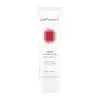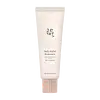What's inside
What's inside
 Key Ingredients
Key Ingredients

 Benefits
Benefits

 Concerns
Concerns

No concerns
 Ingredients Side-by-side
Ingredients Side-by-side

Water
Skin ConditioningZinc Oxide
Cosmetic ColorantCyclohexasiloxane
EmollientDibutyl Adipate
EmollientPropylheptyl Caprylate
EmollientButyloctyl Salicylate
Skin ConditioningDipropylene Glycol
HumectantPolyglyceryl-4 Diisostearate/Polyhydroxystearate/Sebacate
EmulsifyingNiacinamide
SmoothingCalcium Aluminum Borosilicate
Ethylhexyl Triazone
UV AbsorberMethyl Methacrylate Crosspolymer
Bis-Ethylhexyloxyphenol Methoxyphenyl Triazine
Skin ConditioningPolyglyceryl-3 Polydimethylsiloxyethyl Dimethicone
Skin ConditioningDiethylamino Hydroxybenzoyl Hexyl Benzoate
UV FilterTitanium Dioxide
Cosmetic ColorantMagnesium Sulfate
Disteardimonium Hectorite
StabilisingTriethoxycaprylylsilane
1,2-Hexanediol
Skin ConditioningWater, Zinc Oxide, Cyclohexasiloxane, Dibutyl Adipate, Propylheptyl Caprylate, Butyloctyl Salicylate, Dipropylene Glycol, Polyglyceryl-4 Diisostearate/Polyhydroxystearate/Sebacate, Niacinamide, Calcium Aluminum Borosilicate, Ethylhexyl Triazone, Methyl Methacrylate Crosspolymer, Bis-Ethylhexyloxyphenol Methoxyphenyl Triazine, Polyglyceryl-3 Polydimethylsiloxyethyl Dimethicone, Diethylamino Hydroxybenzoyl Hexyl Benzoate, Titanium Dioxide, Magnesium Sulfate, Disteardimonium Hectorite, Triethoxycaprylylsilane, 1,2-Hexanediol
Water
Skin ConditioningHomosalate
Skin ConditioningButyloctyl Salicylate
Skin ConditioningOctocrylene
UV AbsorberEthylhexyl Salicylate
UV AbsorberDipropylene Glycol
HumectantDiethylhexyl 2,6-Naphthalate
EmollientPolymethylsilsesquioxane
Butyl Methoxydibenzoylmethane
UV AbsorberGlycerin
HumectantCaprylyl Methicone
Skin Conditioning1,2-Hexanediol
Skin ConditioningSilica
AbrasiveVp/Eicosene Copolymer
Pentylene Glycol
Skin ConditioningBehenyl Alcohol
EmollientPoly C10-30 Alkyl Acrylate
Emulsion StabilisingPolyglyceryl-3 Methylglucose Distearate
EmulsifyingCetearyl Alcohol
EmollientGlyceryl Stearate
EmollientInulin Lauryl Carbamate
Emulsion StabilisingTromethamine
BufferingCarbomer
Emulsion StabilisingAcrylates/C10-30 Alkyl Acrylate Crosspolymer
Emulsion StabilisingSodium Stearoyl Glutamate
CleansingEthylhexylglycerin
Skin ConditioningPolyacrylate Crosspolymer-6
Emulsion StabilisingOryza Sativa Extract
AbsorbentT-Butyl Alcohol
PerfumingTocopherol
AntioxidantWater, Homosalate, Butyloctyl Salicylate, Octocrylene, Ethylhexyl Salicylate, Dipropylene Glycol, Diethylhexyl 2,6-Naphthalate, Polymethylsilsesquioxane, Butyl Methoxydibenzoylmethane, Glycerin, Caprylyl Methicone, 1,2-Hexanediol, Silica, Vp/Eicosene Copolymer, Pentylene Glycol, Behenyl Alcohol, Poly C10-30 Alkyl Acrylate, Polyglyceryl-3 Methylglucose Distearate, Cetearyl Alcohol, Glyceryl Stearate, Inulin Lauryl Carbamate, Tromethamine, Carbomer, Acrylates/C10-30 Alkyl Acrylate Crosspolymer, Sodium Stearoyl Glutamate, Ethylhexylglycerin, Polyacrylate Crosspolymer-6, Oryza Sativa Extract, T-Butyl Alcohol, Tocopherol
 Reviews
Reviews

Ingredients Explained
These ingredients are found in both products.
Ingredients higher up in an ingredient list are typically present in a larger amount.
1,2-Hexanediol is a synthetic liquid and another multi-functional powerhouse.
It is a:
- Humectant, drawing moisture into the skin
- Emollient, helping to soften skin
- Solvent, dispersing and stabilizing formulas
- Preservative booster, enhancing the antimicrobial activity of other preservatives
Butyloctyl Salicylate is a chemical UV filter structurally similar to octisalate. It is a photostabilizer, SPF booster, emollient and solvent. This ingredient helps evenly spread out ingredients.
According to a manufacturer, it is suitable for pairing with micro Titanium Dioxide, Zinc Oxide, and pigments.
Photostabilizers help stabilize UV-filters and prevents them from degrading quickly.
Learn more about Butyloctyl SalicylateDipropylene Glycol is a synthetically created humectant, stabilizer, and solvent.
This ingredient helps:
Dipropylene glycol is technically an alcohol, but it belongs to the glycol family (often considered part of the ‘good’ alcohols). This means it is hydrating and gentle on skin unlike drying solvent alcohols like denatured alcohol.
As a masking agent, Dipropylene Glycol can be used to cover the smell of other ingredients. However, it does not have a scent.
Studies show Dipropylene Glycol is considered safe to use in skincare.
Learn more about Dipropylene GlycolWater. It's the most common cosmetic ingredient of all. You'll usually see it at the top of ingredient lists, meaning that it makes up the largest part of the product.
So why is it so popular? Water most often acts as a solvent - this means that it helps dissolve other ingredients into the formulation.
You'll also recognize water as that liquid we all need to stay alive. If you see this, drink a glass of water. Stay hydrated!
Learn more about Water